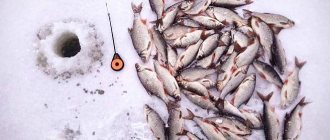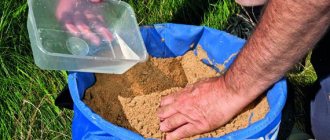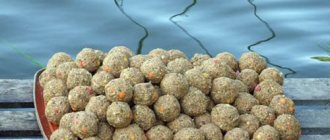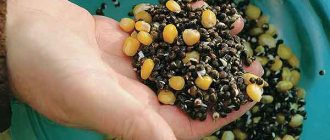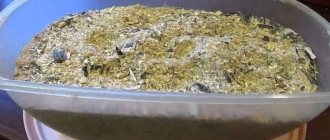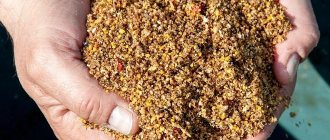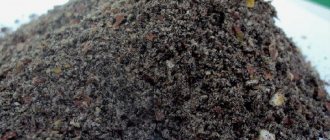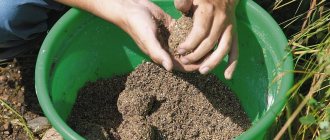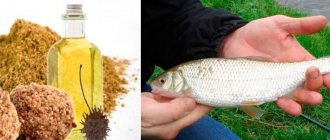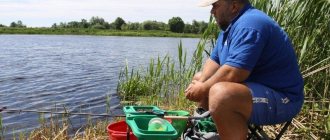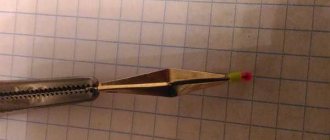Let's go fishing in winter
The roach begins to peck intensively when the first ice appears on the water. It is important to remember that you can only go out on the ice when it is stronger. However, if you want to go fishing, then you shouldn’t delay too much, because... with the advent of real frosts (January - early February), this fish almost does not bite.
The most successful fishing for chebak in winter begins in December, then only from mid-February until the ice melts. The best time is morning and afternoon before sunset. If the weather is clear for at least a couple of days, then the bite will be better than in cloudy weather.
Two words about complementary feeding
Throwing complementary food into a hole in the middle of nowhere means counting on chance. The chebak is inactive during this period; most of the time the flock is in one place. Sprinkling food in the hope of luring fish from afar is useless.
It is too presumptuous to expect that complementary food will fall right under the nose of the flock.
In January and until about mid-February, one thing we can advise is to actively search for a promising hole .
If a chebak bite happens in any hole, you need to put the bait there in small portions in order to collect the lazy fish in one place near the hook.
The rest of the winter, it is worth putting small portions of complementary food into the hole in promising places.
If the hole is working, it is worth constantly adding complementary food in small portions so that the flock does not lose interest in the hole.
Composition of winter complementary food : 30% animal protein + 70% plant food.
You should always remember that fish should be attracted by complementary foods, and not by feeding.
Where to catch chebaka in winter
The chebak overwinters in the deepest places on a river or lake that need to be discovered. The method is this: you need to go deep into the reservoir and drill holes approximately every 10 or 15 meters, checking their depth. When you come across the deepest one or several, it’s worth trying your luck.
It is better to throw fishing rods into a couple of holes at different depths to find out the presence of fish. In some cases, bait will help, but if the bite goes on without it, then you shouldn’t use it - the fish may completely calm down. During thaws, chebak is caught all over the reservoir, except in deep places - from there it already rises.
Recipes for homemade baits for roaches
There are a large number of bait recipes. Let's list some of them. Let's look at several options for winter baits that you can make yourself .
All three bait options can be made at home without any problems.
- A popular recipe involves frying half a glass of buckwheat over low heat, which must be ground after cooling. To do this, you can use a meat grinder or coffee grinder. After this, you need to add a glass of breadcrumbs to the buckwheat. Mix everything, and then add one-sixth cup of barley and oat grains, they can also be ground, and a glass of corn flour. You can add spices such as coriander or cinnamon to act as a flavoring agent.
- An alternative recipe involves the use of live food. You need to mix half a glass of milk powder and a glass of breadcrumbs, adding a little anise to the resulting mixture. Before fishing, you need to add chopped worms or bloodworms to the bait.
- The third bait recipe involves mixing a glass of wheat, breadcrumbs and pre-fried and ground sunflower seeds. To all this is added two-thirds of a glass of bran. You can add flavoring to the bait, however, with such a mixture of ingredients, go overboard with adding spices. Before feeding, you should add bloodworms or maggots to the mixture.
Immediately before baiting the rafts, add a small amount of water to the dry mixture.
Ingredients that roaches love
Ingredients for bait should be selected based on fishing conditions. If fishing is carried out in a reservoir where there are many fishermen at the same time, then it is worth considering that in such places there is a lot of food for fish. If the bait is scattered throughout the reservoir, then it is necessary to use not only food ingredients, but also live food, that is, maggots or bloodworms. Moreover, there should be a lot of this component in the bait. You can also add sweet cookies to the mixture, which must be pre-soaked.
When fishing takes place in a body of water with a strong current, it is best if the bait contains breadcrumbs and grain bran. Such components form a cloudy trail that is tasty for roaches. To add viscosity, you can add soil to the bait.
If we talk in general about the ingredients that can be used in the preparation of bait, these are the following components:
- ground cereals (unground cereals cannot be used, as they tend to swell and become soggy);
- wheat;
- bran and organic ingredients;
- bloodworm;
- maggots;
- dried worms.
In addition, you can add clay or sand to the bait.
Selection of tackle and bait
Experienced fishermen believe that it is best to catch roach on the bottom (after all, the fish lies on the bottom), and it is better to bite on a nozzle jig. To effectively play with a jig, the nod is long and flexible. Spinning rods are not used for chebak in winter; it would be much more appropriate to fish with a float rod (you can even use two at the same time).
There is a small nuance here - such a fishing rod is suitable for intense bites, and they usually happen a couple of times during the winter. By lowering and raising the bait on the hook, you can determine the depth at which there are fish. The following bait would be suitable:
- Mormyshka.
- Maggot.
- Bread.
- Bloodworm.
If we talk about jigs, then it is advisable to have a set of several pieces with you (the chebak bites better on white and yellow colors) and, if necessary, try different options. Experienced fishermen have noticed that in good weather the chebak bites on bait of any shape and color. Groundbait increases the bite, perfect for:
- Porridge.
- Breadcrumbs.
- Store-bought bait.
- Chopped bloodworm.
- You can add honey or garlic juice.
When using complementary foods, the fish will swim right at the hole. A good option is to release complementary foods in a metal feeder.
Do-it-yourself jig for chebak
Despite the wide selection of finished products, it is important for every fisherman to make a jig with his own hands. Homemade products can take forms that cannot be found in the market network.
Materials used
To make jigs at home use:
- Lead is a medium-weight material for making jigs with the ability to be used to a depth of up to 5 m.
- Tungsten is a heavier material, from which even small baits have enough weight to quickly lower them to great depths.
- Tin makes the lightest jigs for fishing up to 2 m deep. Most often they are made at home using a soldering iron.
- Plastic is used to create flies that are used together with a sinker.
To give jigs a more attractive look, multi-colored beads, beads and rubber threads are used.
Manufacturing procedure
The most common ways to make a jig are: casting, soldering and winding.
To create jigs using the injection molding method, you must have a special mold into which molten lead or lead-tin mass will be placed. This process is labor-intensive and is rarely used at home.
Armed with a soldering iron and a piece of tin, craftsmen create masterpieces that are different from each other. At the same time, there is a lot of good in all of them - the best jig will definitely be found, and only large and rare fish will be caught with it. Using the soldering method, you can make a jig of any shape and size, and build additional attention-grabbing elements on it.
The mechanical method is implemented by winding a copper or tungsten thread onto the hook fore-end and tinning with solder. Given the many hollow areas, such jigs, even if they are of sufficient size, can be light in weight.
Bait shapes
Since the chebak fish is capricious and at certain times may prefer baits of various shapes, it is necessary to always have a whole set of different jigs when fishing, including:
- round pellet;
- elongated oatmeal or drop;
- Uralka;
- ant;
- goat;
- devil;
- witch;
- nymph.
Since it is widespread to make jigs with your own hands, homemade ones differ from generally accepted shapes and sizes, expanding the fisherman’s choice.
Fishing tactics
You can easily miss a roach bite, because it bites carefully. Therefore, if you suspect a bite, you need to make a sharp, but not strong hook. The catch (especially a large specimen) will actively resist, so it is worth landing the fish as carefully and slowly as possible.
A strong smell of bait (for example, bread with anise drops, if there is a lot of it) and sharp movements of the jig can scare away the fish. Winter fishing for chebak is an exciting activity, and to come home with a rich catch, you just need to know a few subtleties. It’s especially nice to catch the spawning of this fish.
Roach feeding technology
Before you start fishing, you should start feeding the fishing point. To do this, several balls are molded and thrown into the water. After this, you should start laying out the gear and arranging the fishing spot. During this time, fish will approach the bait casting site. Subsequently, when the bite begins, the fishing point is fed with small portions of bait.
When fishing with bottom tackle, throwing bait into the fishing point by hand is not realistic, so other methods of delivering bait to the fishing point are used. As a rule, they use bait feeders. After making 5-7 casts with the tackle without a leash and hook, they pause to remove the feeding trough and attach the working one with a leash and hook.
Bait for catching roach in the current in winter
In the presence of a current, the strategy and tactics for catching roach are somewhat different from the fishing conditions in a body of standing water. As a rule, the current can carry bait away from the fishing point, and therefore the bait is thrown slightly higher upstream. Feed is delivered in various ways, depending on the fishing technique. If fishing is carried out from ice, then you can drill a hole upstream and from there deliver food, but you need to fish in a hole that is located downstream. The consistency of the bait should be such that it is gradually washed out. As a result, a stern plume will appear, which should cover the hole where the gear is installed.
Recipe for preparing bait for fishing with the current
To do this you need to prepare:
- 150 g sunflower seeds;
- dried lemon or tangerine zest;
- 200 g breadcrumbs;
- 250 g boiled millet;
- 2 tbsp. spoons of flour;
- 10 pieces of chopped shrimp.
All ingredients are mixed and brought to working condition directly on the pond, using its water. Alternatively, you can roll 5-10 balls and freeze them to make them stronger. The presence of shrimp in the bait allows you to attract fish from a long distance.
Using a feeder for roach fishing
Catching roach on a feeder video: Fishing diary
If you need to catch roach far from the shore, then the ideal tackle is a feeder (bottom tackle). As a rule, feeder equipment is equipped with a feeder, which makes fishing more efficient. At the beginning of the fishing process, small specimens are caught, but over time the size of the individuals increases. Feeder gear is perfect for fishing both on a lake and on a river where there is a current. The feeder in the feeder is also a load that needs to be selected correctly for various fishing conditions.
- For reservoirs without a current, any feeders weighing up to 60 g are suitable.
- For reservoirs with a current, feeders weighing 60 g or more should be used, depending on the strength of the current.
